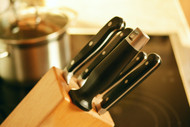How to Recognize a Quality Kitchen Knife (Pt. 1)
Posted by American Edge on Jun 22nd 2020
When shopping for a kitchen knife, you want the best quality knives you can get at the lowest price. The problem is, quality knives are usually not inexpensive and cheap knives are often low in quality. So, how do you know how to judge a quality knife?
Judging The Balance
You may have heard about or seen shoppers attempt to balance a knife on another knife or on their finger. (Be cautious if trying this yourself: many knife makers don’t consider balance and the knife will slide right off!) Unbalanced knives make the user work harder.
To judge the balance for yourself, you don’t need to attempt to balance it on the tip of your finger. Simply grip the knife by the handle. If it feels uncomfortably weighted toward the back of the handle or the blade, it probably isn’t the knife for you.
Understanding Weight
The weight of the knife is about two things: the use it is most often put through and personal preference. Some chefs believe a heavier knife will cut though food easier, while others prefer a lighter knife because they feel it gives them more control. It really comes down to which tasks you spend more time carrying out. Lighter foods and precision tasks are more difficult with a heavy knife, whereas tasks like deboning a chicken or cutting a melon requires a heavier knife. Most chefs will include a combination of knives in their kitchen.
Choosing a Size
The most popular kitchen knives are around 8 inches in length. Longer blades like a 10-inch knife can feel intimidating and harder to control. Smaller blades like a paring knife are better suited for certain agility tasks, but fall short in larger volume functions. Again, you may want a combination of sized knives in your kitchen to handle more chopping and cutting tasks.
Picking a Comfortable Handle
There is some debate as to handle styles. For the most part, this is entirely up to you. There may be some benefits to some styles, but what is most important is using a knife that feels comfortable to you–especially when selecting a knife with a molded grip. Molded grips might work well for you, or force your hand in an uncomfortable position. A good knife should feel comfortable in your grip, and your hand shouldn’t strain to hold it.
In our next installment, we’ll discuss the composition of knife. We’ll discuss carbon steel, stainless steel, and ceramic blades and their benefits and drawbacks. Stay tuned!



